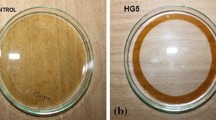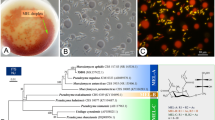Abstract
Biosurfactants are amphipathic molecules, consisting of hydrophobic and hydrophilic domains, which can partition at the interfaces between different fluid phases, such as oil/water or water/air interfaces. Mannosylerithritol lipids (MELs) are a type of glycolipid. The yeast Candida (Pseudozyma) antarctica (ATCC 32657) secretes an extracellular MEL, with biosurfactant properties, when grown on a water soluble and insoluble substrate, such as glycerine or oils. Value added MEL was biologically synthesized, by using two different types of honey as natural and newer water soluble carbon source. Those types of honey as a carbon source were optimized at different concentration of total carbohydrate present in the honey. Further optimized substrate concentration of honey was monitored for 15 days, for studies of MEL yield and cell growth concentration per day on shake flask batch culture. Surfactant properties, such as surface tension, interfacial tension, foaming, emulsification and wetting of MEL, were observed. Produced MEL was confirmed by thin layer chromatography (TLC), Fourier Transform Infrared (FTIR) spectra, and 1H Nuclear Magnetic Resonance (NMR) techniques.
Similar content being viewed by others
References
Desai, J. and I. Banat (1997) Microbial production of surfactants and their commercial potential. Microbiol. Mol. Biol. Rev. 61: 47–64.
Cameotra, S. and R. Makkar (1998) Synthesis of biosurfactants in extreme conditions. Appl. Microbiol. Biotechnol. 50: 520–529.
Banat, I., R. Makkar, and S. Cameotra (2000) Potential commercial applications of microbial surfactants. Appl. Microbiol. Biotechnol. 53: 495–508.
Raiders, R., R. Knapp, and M. McInerney (1989) Microbial selective plugging and enhanced oil recovery. J. Ind. Microbiol. 4: 215–230.
Banat, I. (1995) Characterization of biosurfactants and their use in pollution removal-state of the art. Acta Biotechnol. 15: 251–267.
Klekner, V. and N. Kosaric (1999) In Biosurfactants: Production, properties, applications. pp. 373–389. In: N. Kosaric (ed.), Marcel Dekker Inc., NY, USA.
Kesting, W., M. Tummuscheit, H. Schacht, and E. Schollmeyer (1996) Ecological washing of textiles with microbial surfactants. Prog. Colloid Polym. Sci. 101: 125–130.
Tomotake, M., K. Masaaki, F. Tokuma, Tomohiro, and K. Dai (2007) Microbial conversion of glycerol into glycolipid biosurfactants, mannosylerythritol lipids, by a basidiomycete yeast, Pseudozymaantarctica JCM 10317. J. Biosci. Bioeng. 104: 78–81.
Kitamoto, D., T. Ikegami, T. Suzuki, A. Sasaki, Y. Takeyama, Y. Idemoto, N. Koura, and H. Yanagishita (2001) Microbial conversion of n-alkanes into glycolipid biosurfactants, mannosylerythritol lipids, by Pseudozyma (Candida antarctica). Biotechnol. Lett. 23: 1709–1714.
Hartlep, M., W. Hussmann, N. Prayitno, I. Meynial-Salles, and A. P. Zeng (2002) Study of two-stage processes for the microbial production of 1, 3-propanediol from glucose. Appl. Microbiol. Biotechnol. 60: 60–66.
Lee, P. C., W. G. Lee, S. Y. Lee, and H. N. Chang (2001) Succinic acid production with Reduced by-product formation in the fermentation of Anaerobiospirillum succininiproducens using glycerol as a carbon source. Biotechnol. Bioeng. 72: 41–48.
Zeikus, J. G., M. K. Jain, and P. Elankovan (1999) Biotechnology of succinic acid production and markets for derived industrial products. Appl. Microbiol. Biotechnol. 51: 545–552.
Isoda, H., D. Kitamoto, H. Shinmoto, M. Matsumura, and T. Nakahara (1997) Microbial extracellular glycolipid induction of differentiation and inhibition of the protein kinase C activity of human promyelocytic leukemia cell line HL60. Biosci. Biotech. Biochem. 61: 609–614.
Isoda, H., H. Shinmoto, D. Kitamoto, M. Matsumura, and T. Nakahara (1997) Differentiation of human promyelocytic leukemia cell line HL60 by microbial extracellular glycolipids. Lipids 32: 263–271.
Ligia, R., M. Banat, T. Jose, and O. Rosario (2006) Biosurfactants: Potential applications in medicine. J. Antimicrob. Chemotherapy 57: 609–618.
Worakitkanchanakul, W., T. Imura, T. Fukuoka, T. Morita, H. Sakai, M. Abe, R. Rujiravanit, S. Chavadej, H. Minamikawa, and D. Kitamoto (2008) Aqueous-phase behavior and vesicle formation of natural glycolipid biosurfactant, mannosylerythritol lipid-B. Colloids Surf. B. Biointerfaces. 65: 106–112.
Subramanian, R., H. Umesh Hebbar, and N. Rastogi (2007) Processing of honey: A Review. Internat. J. Food Prop. 10: 127–143.
Allsop, K. and J. Miller (1996) Honey revisited: A reappraisal of honey in pre-industrial diets. Brit. J. Nutr. 75: 513–520.
Crane, E. (1975) History of honey. pp. 439–488. In: Crane, E. (ed.) Honey, a comprehensive survey. William Heinemann, London, UK.
Jones, R. (2001) Honey and healing through the ages. pp. 1–4. In: P. Munn and R. Jones (eds.). Honey and healing. International Bee Research Association IBRA, Cardiff, GB.
Hodge, J. and B. Hofreiter (1962) Determination of reducing sugars and carbohydrates. pp. 380–394. In: R. Wilster and M. Wolfrom (eds.). Methods in carbohydrate chemistry. Academic Press Inc., NY, USA.
Kitamoto, D., S. Ghosh, G. Ourisson, and Y. Nakatani (2000) Formation of giant vesicles from diacyl-mannosylerythritols, and their binding to concanavalin. A. Chem. Commun. 10: 861–862.
Asmer, H. J., S. Lang, F. Wagner, and V. Wray (1988) Microbial production, structure elucidation and bioconversion of sophorose lipids. J. Am. Oil Chem. Soc. 65: 1460–1466.
Rosen, M. J. (2004) Surfactants and Interfacial phenomena. 3rd ed., pp. 277–302. A John Wiley & Sons Inc., Hoboken, NJ.
Seyferth, H. and O. M. Morgan (1938) The canvas disc wetting test. Am. Dyestuff Reporter 27: 525–529.
Ross, J. and G. D. Miles (1941) An apparatus for comparison of foaming properties of soaps and detergents. Oil and Soap 18: 99–102.
Subrahmanyam, V. V. R. and K. Y. Achaya (1961) Structure and surfactant-evaluation of ricinoleyl alcohol. J. Chem. Eng. Data 6: 38–42.
Patil, S. V., S. D. Wadekar, S. B. Kale, A. M. Lali, D. N. Bhowmick, and A. P. Pratap (2011) Effect of glycerol and soybean oil as a carbon source on the production of mannosylerythritol lipids by Pseudozyma antarctica (ATCC 32657). J. Lipid Sci. Technol. 43: 16–20.
Author information
Authors and Affiliations
Corresponding author
Rights and permissions
About this article
Cite this article
Bhangale, A., Wadekar, S., Kale, S. et al. Optimization and monitoring of water soluble substrate for synthesis of mannosylerythritol lipids by Pseudozyma antarctica (ATCC 32657). Biotechnol Bioproc E 18, 679–685 (2013). https://doi.org/10.1007/s12257-012-0647-4
Received:
Revised:
Accepted:
Published:
Issue Date:
DOI: https://doi.org/10.1007/s12257-012-0647-4




